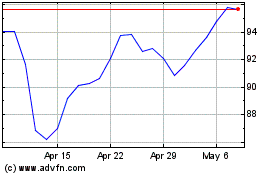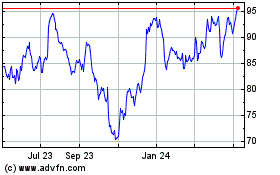Treasury Official:Warrant Negotiations Lead To 'Slightly' Higher Returns
May 11 2010 - 1:35PM
Dow Jones News
The U.S. Treasury Department, on average, has achieved "slightly
better" returns from negotiating warrant repurchases with financial
firms, as opposed to selling warrants, the department's chief
investment officer told lawmakers Tuesday.
David Miller, who heads the Troubled Asset Relief Program's
investment strategies, said in measuring the value Treasury
receives from warrant repurchases and auctions--the department
looks at "implied volatility." The higher the volatility of a
transaction, the greater the value received.
"Comparing implied volatilities suggests that Treasury received
better pricing in its negotiated transactions than it received in
the warrant auctions," Miller said.
On warrant negotiations, Treasury received an average implied
volatility of 35%; while the auctions handed Treasury an average
implied volatility of 33%.
Miller's testimony before a subcommittee of the House Financial
Services Committee comes after an audit of TARP was released
Tuesday morning by Neil Barofsky, the special inspector general for
TARP. Barofsky's report warned that Treasury's program to negotiate
and sell billions of dollars of warrants received from banks that
got government aid could favor some financial firms over
others.
At issue is a lack of detailed documentation regarding what
information is shared with banks who are attempting to repurchase
their warrants. According to the report, Treasury's estimated
market value and the price the department was willing to accept on
warrant repurchases was provided to some banks, while other banks
received no guidance.
Linus Wilson, a University of Louisiana at Lafayette finance
professor who has been closely following the government's warrant
auctions, testified at the hearing as well. While Wilson primarily
testified about Treasury's efforts to recoup taxpayer dollars, he
said via email the audit report "raises some interesting issues
about Treasury personnel feeding banks their minimum acceptable
bids."
"If I told my students, that $1.2 million was the answer to
question one on the test; then they would answer $1.2 million," he
said. "That would not be ethical and, in the U.S. Treasury's case,
that can cost taxpayers hundreds of millions of dollars on a single
transaction."
It's unfair for one bank to receive a better deal over another,
Wilson said, adding that a general rule should be in place
mandating Treasury officials refrain from discussing prices with
bidders.
Answering lawmaker questions related to the topic, Miller said
each firm's warrant negotiation proceedings must be handled
differently because firms' circumstances are unique.
Barofsky's report said Treasury needs to increase the
transparency of its warrants negotiations to avoid being
criticized--"fairly or unfairly"--that it is favoring some
institutions over others.
Despite the concerns about transparency raised by Barofsky,
Treasury officials have been able to drive a hard bargain with some
firms, particularly major banks such as Goldman Sachs Group Inc.
(GS) and Morgan Stanley (MS), rejecting bids that were in line
with, or above, internal and external estimates.
As of May 5, Treasury has received about $6 billion from warrant
repurchases and auctions, Miller said. That's in addition to $2.6
million Treasury received from preferred stock repurchases by six
privately held banks.
On Treasury's effort to leverage more dollars from larger firms,
Miller pointed out the larger firms--all of whom have since repaid
their TARP aid--received the bulk of bailout funds. Still, he said
Treasury treats all banks the same--despite it being harder for his
team to determine the value of warrants from the roughly 655
remaining smaller firms.
When all is said and done, Treasury's goal remains: to monetize
its warrant holdings as soon as possible in a "prudent and
sensibly" manner.
-By Darrell A. Hughes, Dow Jones Newswires; 202-862-6684;
darrell.hughes@dowjones.com
Morgan Stanley (NYSE:MS)
Historical Stock Chart
From Mar 2024 to Apr 2024

Morgan Stanley (NYSE:MS)
Historical Stock Chart
From Apr 2023 to Apr 2024
